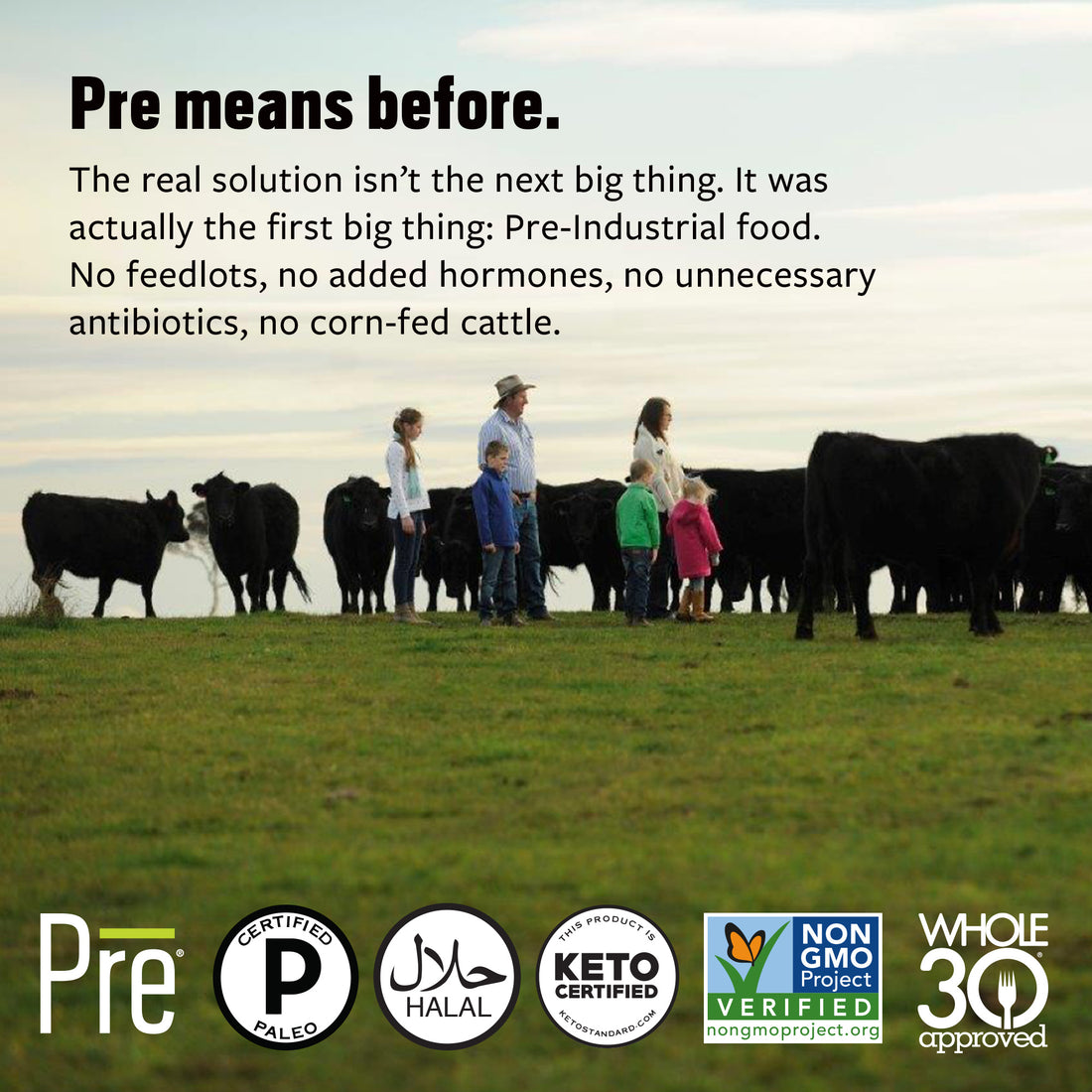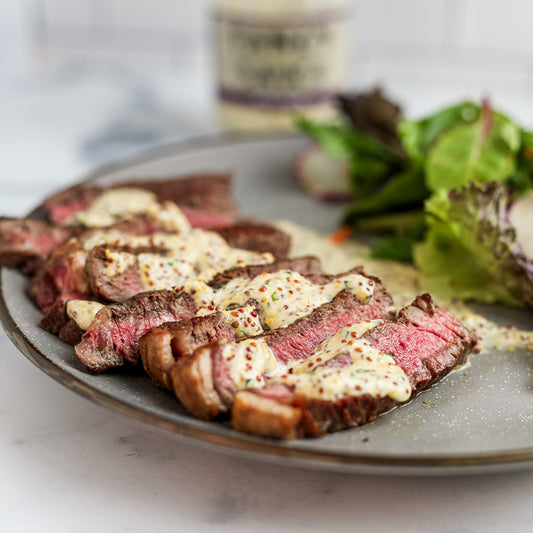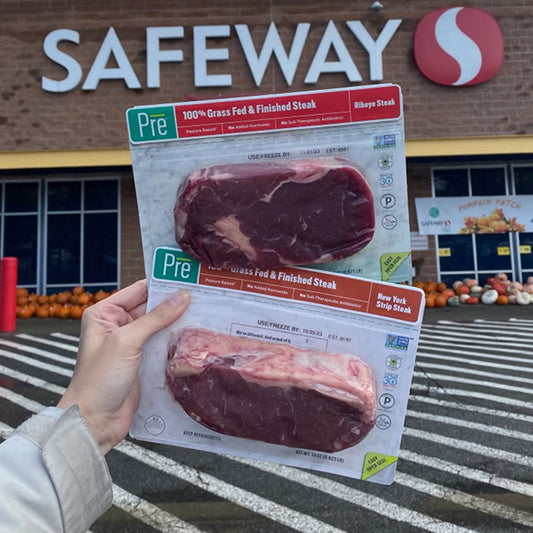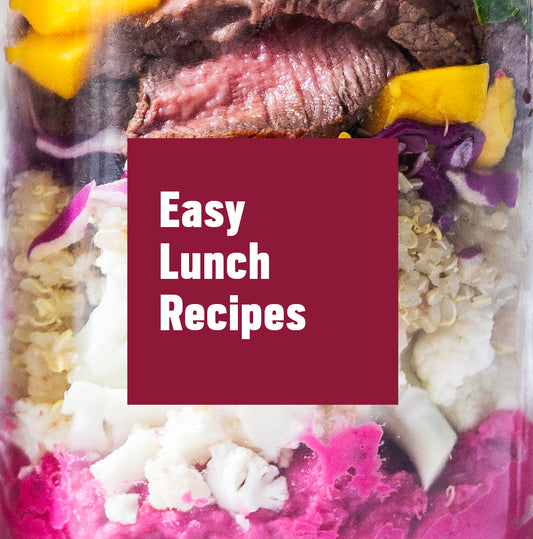
We Found the Best Beef Ever—Our Quality Standards
Julie DivisHow do you find the best beef? You do your homework and make a checklist.
Have you ever wondered, "What really makes beef high-quality anyway?" Most people say high-quality, but can they give you 15 reasons why it is the best beef you can buy and then back it up with the science to prove it? We can. Let us tell you about our process, and how we’ve found the best beef ever.
If you’ve read our story, you might know that our founder created Pre after he traveled the world and encountered one of the most delicious steaks he’d ever eaten – in Australia. He had to know why the taste was so distinctly different and flavorful. Turns out we've got 15 different reasons why this beef was so great. And these 15 reasons don’t even include the fact that our beef is Non-GMO Project verified.
That is a lot all packed into one juicy ribeye! So, without further ado, let’s get into the deeper details about these 15 reasons, and explain why we’ve chosen to partner with certified, reputable grass fed beef farmers to provide you with the best meat and the highest quality!
1. Source
It’s all about the climate. Our beef is sourced from select areas in the world with ample rainfall and where the daytime temperature ranges from 50 - 70F depending on the season. This is the perfect place for grass to grow and absorb nutrients – and these are passed onto the cattle as they munch on it!

2. Class
We only use Steers and Heifers. Steers are castrated males and Heifers are females that have not given birth to a calf. Part of the reason we have the best beef is that we don’t source meat from bulls or cows. Bulls are males used to populate the herd, while cows are animals that have given birth (and are then used for the dairy industry).
3. Breed
There are many different breeds of cattle. We only use British breeds, as they are smaller and provide more tender beef. Other types of breeds, like Tropical breeds, for example, are usually tougher animals. They can even be raised in desert-like areas because they can handle the heat. We do not use these types of breeds, as the meat tends to be more tough and less tender.

4. No Added Hormones
All cattle have hormones; they are living creatures! Just like humans and all other animals, cattle naturally produce the hormones they need to produce the best meat!
The term “no added” means that our beef is not given additional, non-naturally occurring hormones to promote growth. It isn’t necessary, but factory farms often have to do this because their cows are stunted due to the poor conditions in their facilities.

5. No Added Antibiotics
Antibiotic use should not be used as a preventative measure. The few sick animals that are treated with antibiotics by a trained veterinarian are removed from the herd until the antibiotics have left their system.
We call this a withholding period. This is why we use the term “no sub-therapeutic antibiotics” when claiming no antibiotic use. You can’t get the best beef ever by injecting cows with unnecessary antibiotics.
Antibiotics use is extremely uncommon in the areas that we source from, as pastoral farming practices limit an animal’s exposure to disease. Basically, since cows are not packed together in giant factories, disease spreads more slowly and is less dangerous, and sick cows can be identified faster! New Zealand and Australia have some of the lowest rates of antibiotic use in the world. Sure, we may be biased, but we think that it’s no coincidence that this is where the best beef in the world comes from.
6. Grass Fed & Finished
All grass, all the time. Our cattle are not finished on corn or other grains to help them gain weight, which is a common practice at some other farms. Instead, they are kept on pasture for their entire lives, munching away on grass – just like Nature intended!

7. Pasture Raised
Not only are our cattle grass fed and finished, but they are also pasture-raised. And they are pasture-raised year-round. This is why the countries we source from are so great, they can keep cattle out on pasture all year long because of the climate. There are alternatives to year-round pasture feeding, but grass pellets disguised as feed to claim grass-finished is not the same. Pasture is where it’s at – and it results in the best meat possible!
8. Marbling Score
Marbling is the intramuscular fat that flows throughout the meat. We have specific, numerical scores that we adhere to to ensure consistency. Too little marbling, and the meat can be tough and chewy. Too much, and you just won’t get enough protein or meat. We treat our marbling like Goldilocks and the three bears. Not too much, not too little - just the right amount for the perfect, flavorful steak.
9. Fat Color
Did you know that grass fed and finished beef will have a more ivory color of fat compared to the extremely bright white fat of grain fed beef? This subtle yellow color is thanks to beta-carotene, the same compound that gives color to carrots. That’s just another sign of how nutritious the best beef ever from Pre is – you won’t find this fat color in grain-fed beef.
10. Meat Color
We have a tight specification on meat color, ensuring that our beef is not too dark or not too pale. Why? Well, meat color is a great indication of how stressed an animal was prior to slaughter, and it relates to pH of the muscle too.
Let’s take a look at meat that is too dark. The dark color is because the pH did not drop to normal levels and remained high. A stressed animal will use up its glycogen reserves (energy) while dealing with the stress so that after slaughter there isn’t enough glycogen to be converted to lactic acid, which lowers the pH of the muscle.
Because the pH remains high, the meat becomes a dark, purple/black color. When cooked, this dark meat can be tough and dry, and will usually spoil faster. We adhere to strict meat color parameters, which ensures our cattle were not stressed prior to slaughter.
11. Ossification
You are probably thinking “What the heck is Ossification, and did I even say that right?” Ossification is the process of bone formation. Now, get this, the more bone that has formed in the spine of a beef cow, the more stressed that animal’s life was. Stress can negatively affect bone production and growth as the animal grows, and this shows in the spine.
If the cattle has more cartilage and less bone, though, it lived a happy and nutritionally balanced life.
The “ossification score” is a method of checking the bones of a slaughtered animal to look at its age, stress levels, and overall quality of life before it was butchered for its meat.
While many people look at the age of the animal, we prefer to look at the quality of life. A young animal that has a high ossification score did not have the best quality of life. And a more mature animal that has a low ossification score lived a great life, enjoying pasture and happily eating up all the delicious grass.
That all adds up to the best meat possible. In fact, while young cows are often prized, older cows that have seen less stress may provide more tender meat!
12. pH Range
We talked a little bit about this above in reference to meat color, and pH is important to monitor to ensure animals are not stressed prior to slaughter. But pH also keeps us on track for tender, juicy steaks. Muscle fibers with a pH that sits outside of our tight range can have a hard time holding onto water, which causes moisture loss when cooked. This results in tough steak and ain’t nobody got time for that.
13. Humane Animal Treatment
For us, this is key. Animals should be treated with respect. And it’s no coincidence that happy, well-treated animals result in delicious, high-quality, nutritious beef. The countries that we source from have strict legislation relating to humane treatment, and closely follow the internationally accepted Five Freedoms:
1. Freedom from hunger and thirst
2. Freedom from discomfort
3. Freedom from pain, injury, and disease
4. Freedom to express normal behaviors
5. Freedom from fear and distress

14. Wet Aging for Tenderness
At a minimum beef should be aged at least 21 days to develop flavor and become tender. There are two different kinds of aging: Wet and dry. We use wet aging, which means our beef is vacuum packaged in its subprimal form so that the enzymes naturally present in beef can break down the muscle fibers and tenderize the meat.
Lucky for us, this aging process happens while our beef is in transit from New Zealand or Australia to Chicago, so there are fewer delays and you can get tender, juicy steaks delivered right to your door from our online store more easily.
15. Consistent Size and Weight
There should be no guessing when it comes to cooking your Pre beef. We cut all of our steaks to a fixed weight, which means every steak you buy from us will be the same weight, every time.
No more “price per pound” when you go up to the butcher counter, which inevitably leaves you with a big, thin steak you don’t know what to do with. And we go one step further to measure and control the size of our subprimals.
This allows us to cut steaks at a consistent thickness too. We’ve done all the work behind the scenes to help you confidently cook your steak to the perfect doneness.
So grab a few Pre steaks and your favorite cast-iron pan, sear the meat, and dig in. Once you’ve tasted the best beef ever, you won’t be able to go back – that’s an ironclad guarantee.
Learn more about grass fed beef:
Interested in learning more about why Pre provides the best beef from grass fed cattle? Here are some more resources you can check out!
- The Big Fat Truth About Pasture Raising Cattle
- Grass Fed vs. Organic
- Best Way to Cook Steak in the Oven
- What are sub-therapeutic antibiotics?
- How to Cook Steak on Grill
Where can I buy Pre beef near me?
Find a grocery store near you by checking out our store finder or shop our beef online and on AmazonFresh. Once you’ve tried our best beef ever, you won’t be able to go back – whether you’re buying steaks, ground meat, organ meats, or any other product! Give Pre a try now, and see what all the fuss is about.




